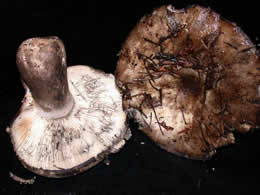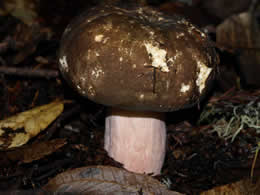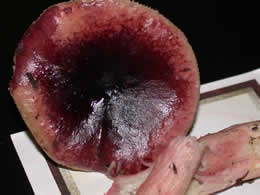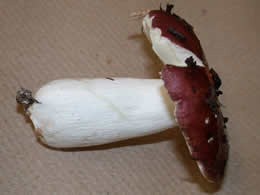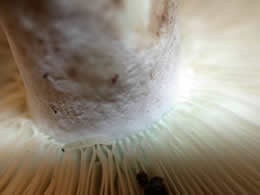BAMS/UC Davis Russula Blitz
Bodega Marine Lab, December 12, 2009
Did it rain yesterday??! You sure wouldn't have guessed it by the happy faces of the many participants in yesterdays BAMS/UC Davis Russula Blitz. Our Gore-Tex™ clad throng scattered into the magnificent Salt Point State Park woods to (mostly) ignore the vast and stunning diversity scattered everywhere, to concentrate on an often disdained group of mushrooms — the Russulas.

Unpacking some of the day's finds. Russulas and more. © Photo by David Rust
And collect them we did, with baskets brimming with densifolia and albonigra, xerampelina and nigricans, brevipes and olivacea, murrillii and frangrantissima, tenuiceps and the maddeningly diversely colored cremoricolor, not merely "cream", but pale yellow, pink and red. As well as many collections of locally common, unnamed (but numbered) russula species, as well as some that Dr. Mike Davis, Professor of Plant Pathology at UC Davis and our Salt Point russula expert, had never seen before!
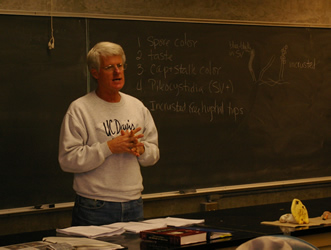
Dr. Davis gives an introduction to some of the features of
Russulas that are used to identify them. © Photo by David Rust
Our goal as a club was to partner with UC and help to elucidate some of the russula diversity, and we all accomplished that goal handily. There was a lot out there for an experienced taxonomist to pick and choose from, and all backed by DNA samples for eventually work-up in the Davis lab.
Do I now have a deep understanding of this difficult to ID genus? Well, no. But I do feel like I have gotten my whole foot into the water, as opposed to just the tip of a toe. And it was interesting to learn of the macro, micro and chemical ways to deliniate members of this genus. And I DO feel a lot more confident in identifying those in the blackening russula group, and am starting to get a pretty decent species concept for a few others. Plus, I am thinking hard about a name for that cool and distinctive, big yellowing russula with brown spots — guess that those published amanita names will have to come later!

Participants discuss some identifications. © Photo by David Rust
OK, yeah, it rained, but it was clear sailing on the way up the coast to our rendezvous, and frankly it is so blissful to be in that beautiful woods, fungi literally everywhere underfoot, and me all warm and dry in my head to toe covering of smartwool and Gore-Tex™ that I hardly noticed my dripping cuffs. And fifty degrees ain't nothin' compared to hiking in thirty degree temps the day before. It was pretty hard to see in that dark dark woods though, and this was at high noon! Luckily, you couldn't help but stumble over mushrooms, and darned if they didn't seem to all be calling my name.
Really, the hardest part of walking that woods was trying to ignore the splendid diversity. I collected very little other than a great diversity of russula, but I did notice (and some did creep into my basket) all of these other species, too — Agaricus subrutilescens, abundant under redwood; Agaricus hondensis, with its thick felty ring (a member of the barficus group) tempting the unwary, corals in all colors of the rainbow, Amanita franchetii in brown and yellow caps, showing the red staining typical of the section validae group, my first Amanita silvicola of the year (our smallest, shortest, fluffiest white lepidella in Northern CA), young and mature Gomphus floccosus, adorable, small and handsome pigs ears (Gomphus clavatus), chanterelles golden and white and even black (just try and see those Craterellus is a dark woods!), matsutakes, one huge, halved Boletus regineus with a pristine stalk, in the tanoak, cut by a forager and left for dead, the big, beautiful, clustered blue Albatrellus flettii (with brand new fruit bodies poking up at the base of every tree in a small grove) and the tiny blue on blue Albatrellus caeruleoporus, Tricholomas of many species including a stunning cluster of apparent T. saponaceum with a dark green cap and heavily ornamented stipe, robust Hygrophorus russula in small, strawberry pink groupings, huge veins of an orange-capped, wine-red streaked, fat stiped Phaeocollybia sp. literally bursting out of the ground, Lactarius species, like L. rubidus (the candy cap) and L. pallescens, whose white latex stains the gills purple, and L. xanthogalactus with its yellow latex, and the greening L. deliciousus.
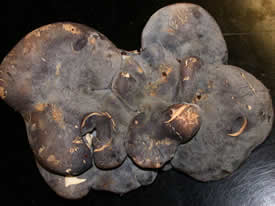
Albatrellus flettii top © Photo by Darvin DeShazer |
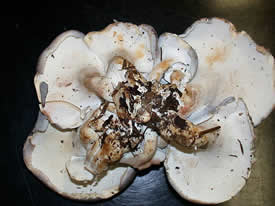
Albatrellus flettii bottom © Photo by Darvin DeShazer |
I couldn't resist putting a few of the toothsome Hydum repandum into my basket, one of the few wild mushrooms that I still enjoy eating. And my favorite olfactory stimulating fungus, Camarophyllus russocoriaceus, with its unique smell of cedar or Russian leather.
Back at the Bodega Bay Marine Laboratory that afternoon, we piled tables high with our finds — the majority russulas, but plenty of other pretty and curious things that caught our eyes.
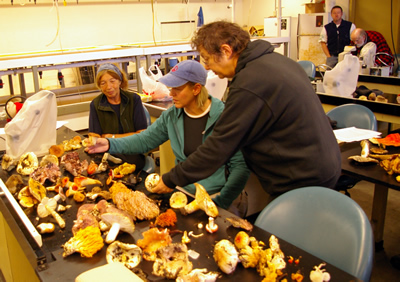
Newcomers to mushrooms were amazed at the color and diversity. © Photo by David Rust
But it was the russulas that we concentrated on. Dr. Mike Davis passed out his key to Salt Point russulas and another page on the chemical and microscopic identification of these species. And the excellant scopes in this lab were at our disposal, along with a broad array of chemicals. Working most assiduously at their lab benches were Darvin DeShazer and Alan Rockefeller and Erin Page Blanchard, old school and new, sharing a common love of learning and a passion for teasing out the mysteries of our fungal friends.
BAMS was delighted to provide another opportunity for folks to go deeper. And as is true of the vast majority of our events, the only cost was one's own time and effort. Working together in harmony, we can make a difference.
Debbie Viess

